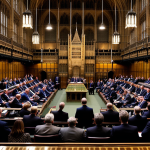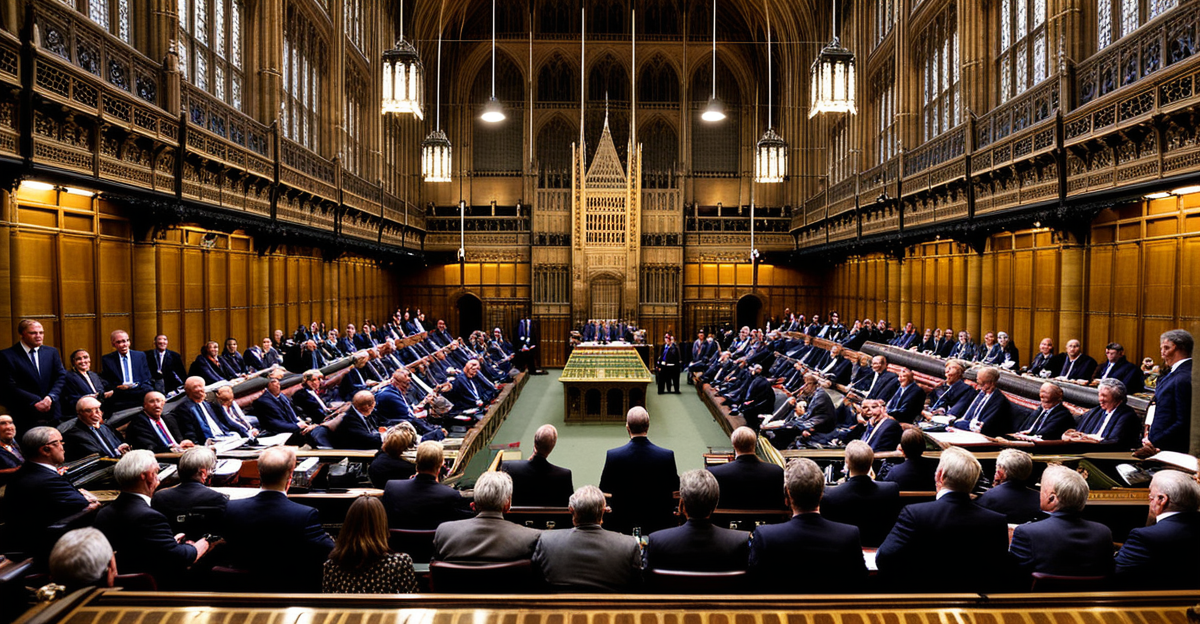Key Recent Changes in UK Parliament
Recent parliamentary shifts in the UK Parliament have been marked by significant elections and notable changes in party majorities. The latest elections resulted in a realignment that altered the balance of power, affecting how parties cooperate or compete. For example, some constituencies switched allegiances, leading to fluctuating party majorities that no longer guarantee a straightforward legislative process.
Leadership within major parties has also undergone changes. New party leaders bring different priorities, which can dramatically shift parliamentary dynamics. These shifts include both leadership contests and broader party realignments, which often occur in response to internal pressures or electoral feedback. Such changes influence debates, voting patterns, and legislative agendas.
Topic to read : Enhance your living space using skylights for pitched roofs
The implications for governance are significant. When party majorities are slim or shifting, the UK Parliament may experience challenges in passing legislation efficiently. This volatility demands greater negotiation and coalition-building. It also introduces uncertainty into policy stability, compelling government officials to adapt quickly to evolving parliamentary compositions. Understanding these dynamics is crucial for anticipating how upcoming UK Parliament changes will shape the political landscape and decision-making processes.
Key Recent Changes in UK Parliament
Recent UK Parliament changes have significantly altered the political landscape. The latest parliamentary elections resulted in notable shifts in party majorities, with the ruling party’s margin narrowing, affecting governance stability. Such recent parliamentary shifts have influenced the balance of power, creating scenarios where coalition-building or cross-party negotiations become essential.
Have you seen this : How do UK news organizations ensure accuracy in their reporting?
Leadership changes further illustrate these dynamics. Several key party leaders have been replaced or repositioned, reflecting strategic realignments within major political groups. These party majorities and leadership modifications have been critical in shaping the legislative agenda and determining parliamentary voting behaviour.
The implications are clear: shifts in party majorities challenge predictable governance and influence how smoothly policies advance through Parliament. As the majority fluctuates, so do political alliances and legislative priorities, impacting government effectiveness. Understanding these UK Parliament changes is vital for grasping the broader implications on policy-making and national direction in the coming months.
Immediate Policy Implications of Parliamentary Changes
Recent shifts in the UK Parliament composition significantly reshape legislative priorities. A new parliamentary makeup often redirects the government’s agenda, emphasizing policies aligned with the dominant factions. When party majorities are narrow or altered, urgent bills may be delayed or require extensive negotiation, impacting the government’s ability to deliver prompt solutions.
For example, changing party majorities can lead to recalibrated budgets or policy targeting sectors like healthcare or economic recovery. Legislative agendas become more fluid, reflecting the balance of power among parties. This dynamic affects not only new proposals but also ongoing initiatives, potentially stalling or accelerating projects depending on parliamentary support.
The policy impact extends to short-term decisions that directly influence UK citizens, such as tax changes, social welfare adjustments, and public service funding. A parliament with shifting allegiances may result in fluctuating support for priority bills, thus affecting the government’s direction. Understanding these immediate effects is essential for anticipating how political developments translate into tangible policy changes affecting daily life across the UK.
Immediate Policy Implications of Parliamentary Changes
Recent UK Parliament changes have a direct effect on policy impact, especially as the newly configured Parliament sets legislative priorities. When recent parliamentary shifts alter party majorities, the government’s agenda must adapt, focusing on achievable goals under the new composition. This often means urgent policies, like economic stimulus or public health measures, may take precedence to respond swiftly to public needs.
A significant result of these shifts is the influence on ongoing government initiatives. If the ruling party’s majority narrows, policies previously seen as certain could face delays or amendments. For example, legislation related to welfare reforms or infrastructure projects might encounter additional scrutiny or require negotiation with smaller parties. This dynamic directly affects the UK government direction, compelling policymakers to prioritize legislation likely to gain sufficient support.
Short-term decisions, such as budget adjustments or emergency regulations, become necessary to maintain governance stability amid uncertainty. These choices impact citizens by shaping immediate public services and regulatory environments. Consequently, understanding the link between policy impact and parliamentary composition helps clarify how UK government direction evolves day by day, reflecting the balance of power and shifting legislative priorities in real time.
Key Recent Changes in UK Parliament
Recent UK Parliament changes have been shaped prominently by elections that redefined party majorities, leading to a more fragmented and competitive environment. These recent parliamentary shifts have resulted in no single party holding a decisive majority, increasing the necessity for alliances and tactical cooperation across party lines to ensure legislative success.
Leadership turnovers have also played a crucial role. Newly appointed leaders in major parties bring fresh political agendas, further recalibrating parliamentary dynamics. These leadership changes often occur due to internal party reviews or the pressure created by electoral outcomes. The realignment within and between parties not only reconfigures influence but also impacts legislative focus and political discourse.
The evolving balance of party majorities complicates governance. As majorities become slimmer or change frequently, the government must navigate increased negotiation and consensus-building. Such volatility can delay decision-making processes, making the passage of bills less predictable. This volatility also forces both government and opposition to adapt quickly as they respond to shifting parliamentary strengths, underscoring the delicate nature of current UK legislative affairs.
Sectoral Impact: Economy, Health, and Immigration
Changes in the UK Parliament composition directly influence economic policy decisions. Recent parliamentary shifts bring new leadership priorities that may emphasize fiscal tightening or stimulus depending on party majorities. For instance, a reduced majority often compels compromises affecting budget allocations, taxation, and business regulations. This evolving landscape demands careful balancing to maintain economic stability while fostering growth.
In healthcare legislation, alterations in parliamentary dynamics can reshape funding and service delivery. Narrow party majorities tend to slow or amend healthcare reforms as negotiations with smaller parties become necessary. Key areas likely affected include NHS funding, wait times, and public health initiatives. Legislative priorities in health may reflect urgent responses to ongoing challenges such as staffing shortages or pandemic preparedness.
Regarding UK immigration policy, recent parliamentary shifts shape border management and visa regulations. The impact of altered party majorities compels adjustments to immigration targets and enforcement measures. Debates around integration, labor markets, and asylum processes become more complex as parties seek parliamentary consensus.
Overall, economic policy, healthcare, and immigration will experience fluid policy directions, grounded in the changing balance of power within the UK Parliament. This underscores the significance of understanding party majorities when evaluating sector-specific legislative outcomes.
Key Recent Changes in UK Parliament
Recent UK Parliament changes have been underscored by significant electoral outcomes that altered the landscape of party majorities. These recent parliamentary shifts saw several constituencies switch allegiances, leading to a more fragmented Parliament where no single party holds a clear majority. This has increased reliance on cross-party cooperation and strategic alliances to secure legislative approvals.
Leadership transformations have been another major factor. Several parties experienced leadership changes or internal realignments, with new leaders introducing distinct priorities that influence legislative focus and overall party strategy. These changes reflect both internal pressures and voter sentiment shifts, driving redefined roles within Parliament.
The evolution of party majority dynamics brings practical governance challenges. As majorities narrow, the government faces increased negotiation demands and greater unpredictability in enacting legislation. This fluctuating power balance compels political actors to be more adaptive, leading to more complex and prolonged decision-making processes. Understanding these dynamics is essential to comprehend how UK Parliament changes are reshaping the legislative environment and impacting policy outcomes.
Key Recent Changes in UK Parliament
Recent UK Parliament changes reflect significant outcomes from recent elections, reshaping the political balance through fluctuating party majorities. Notably, these elections have fragmented previous dominant positions, leading to the absence of a clear majority and requiring more intricate cross-party collaboration. This environment forces parties to adopt strategic negotiation behaviors to advance legislative agendas effectively.
Leadership transformations accompany these electoral outcomes. New party leaders have stepped into roles within major political groups, underlining shifts in internal dynamics and policy focus. These leadership changes often arise from both electoral pressure and internal party deliberations, spurring realignment in parliamentary priorities. Such adjustments inevitably influence how parties communicate, develop strategies, and respond to constituents’ demands.
The evolving landscape of recent parliamentary shifts has important governance implications. Slimmer or unstable party majorities increase uncertainty around passing legislation, demanding tactical coalition-building and often slowing legislative momentum. Governments must now engage in more consensus-driven policymaking, adjusting swiftly to ongoing changes in parliamentary support. This volatility underscores how crucial understanding these changes is for predicting political stability and legislative efficiency in the UK’s current parliamentary framework.
Key Recent Changes in UK Parliament
Recent UK Parliament changes predominantly stem from pivotal elections reshaping party majorities. Several constituencies experienced shifts, reducing the dominance of previous majorities and resulting in a more fragmented Parliament. This fragmentation requires parties to engage in coalition-building, making legislative consensus harder to achieve.
In addition to election outcomes, leadership changes within key political parties are critical. New leaders bring revised strategies reflecting internal party dynamics and electoral feedback. These realignments influence parliamentary debates and voting behavior, altering the power balance further. Such leadership turnovers often signal shifts in party priorities, affecting policy direction and parliamentary cohesion.
The dynamics of party majorities have become increasingly fluid. Slimmer or unstable majorities force the government into more active negotiation with opposition and smaller parties. This volatility makes the legislative process less predictable and complicates governance. Consequently, these recent parliamentary shifts intensify the need for strategic adaptability among lawmakers and affect the overall efficiency in passing legislation within the UK Parliament.
Key Recent Changes in UK Parliament
Recent UK Parliament changes have been driven primarily by notable elections that reshaped party majorities and parliamentary composition. These recent parliamentary shifts resulted in several constituencies changing hands, producing a more fragmented Parliament with no party holding a decisive majority. This scenario intensifies the need for alliances and negotiation, as legislation often requires broad consensus to pass.
Leadership changes within major parties have further complicated the landscape. New leaders have introduced distinct agendas and strategic approaches, influencing party cohesion and legislative priorities. These shifts reflect internal realignments and responses to electoral outcomes, impacting parliamentary debates and decision-making.
The dynamics of party majorities have grown increasingly volatile. Narrow or shifting majorities complicate governance, forcing the government to engage in more frequent negotiations with smaller parties or independents. This leads to uncertain legislative timelines and heightened political responsiveness. The evolving balance demands adaptability from all political actors, underscoring the complex nature of current UK Parliament changes and their significant implications for legislative effectiveness and political stability.
Key Recent Changes in UK Parliament
Recent UK Parliament changes have been predominantly shaped by significant electoral outcomes that redefined party majorities, introducing a more fragmented political environment. These recent parliamentary shifts led to no single party holding a clear majority, intensifying dependence on inter-party negotiations and alliances to pass legislation. This altered balance of power demands increased cooperation, particularly among smaller or diverse parties, to achieve legislative goals.
Leadership transformations have further influenced parliamentary dynamics. Several key parties have witnessed leadership turnovers or internal realignments, prompted by electoral pressures or strategic reassessments. These leadership changes recalibrate party priorities and influence voting behaviours, affecting both the tone and substance of debates. Such shifts often reflect attempts to realign party strategies with evolving public sentiment.
The instability of party majorities presents practical governance challenges. Narrow or fluctuating majorities complicate the legislative process, requiring more negotiation and consensus-building. This volatility fosters unpredictability in passing bills and mandates adaptability among lawmakers. Consequently, understanding these parliamentary developments is essential for grasping current governance complexities and anticipating future parliamentary behaviour in the UK.
Key Recent Changes in UK Parliament
Recent UK Parliament changes have been driven by pivotal elections reshaping party majorities and parliamentary dynamics. These elections led to several constituencies switching hands, reducing dominant majorities and creating a fragmented Parliament without a single party in full control. This fragmentation necessitates increased coalition-building and tactical cooperation to advance legislation.
In addition to electoral shifts, leadership changes have played a critical role. New party leaders with distinct agendas have emerged, reflecting both electoral feedback and internal party realignments. This leadership turnover influences parliamentary debates and recalibrates the strategic direction of parties, directly impacting legislative priorities.
The dynamics of party majorities have become more fluid and less predictable. Slimmer majorities compel governments to negotiate regularly with opposition and smaller parties, complicating governance and extending the legislative process. This volatility enforces a political environment demanding adaptability and consensus-building, making it essential for stakeholders to closely monitor how these recent parliamentary shifts continue reshaping UK governance.
Key Recent Changes in UK Parliament
Recent UK Parliament changes have been chiefly shaped by notable elections that altered party majorities, resulting in a more fragmented and competitive Parliament. Several constituencies witnessed shifts, reducing the dominance of previously stable majorities and intensifying the need for cross-party negotiation and alliance-building. These recent parliamentary shifts create a complex legislative environment where passing bills requires broader consensus beyond traditional party lines.
Leadership changes compound this dynamic. New leaders in major parties often emerge following electoral pressures or internal reviews, bringing distinct policy priorities and strategic approaches. Such leadership turnovers impact parliamentary behaviour by influencing voting patterns and setting fresh agendas. These party realignments reflect both external electoral feedback and internal party recalibrations.
Changes in party majorities have directly affected governance by increasing unpredictability in legislative processes. Narrower or fluctuating majorities compel governments to engage more frequently in negotiation with opposition and smaller parties, complicating decision-making and potentially slowing legislation. These volatile shifts necessitate adaptability from all political actors and significantly influence how effectively Parliament operates. Understanding these developments is crucial for anticipating ongoing parliamentary trends and their effects on UK governance.







